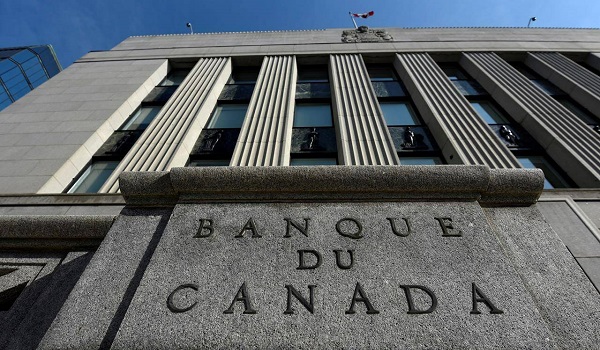It’s anticipated that the Bank of Canada will hold rates firm, even with inflation back in target range
The Bank of Canada is expected to stay the course on interest rates this week and remain tight-lipped about the timing of future cuts, even as the pace of inflation has fallen back within the central bank’s target range.
Bay Street analysts see the bank keeping its policy rate at 5 per cent on Wednesday for the fifth consecutive rate announcement. After increasing borrowing costs ten times in 2022 and the first half of 2023, the bank has been on hold since July, waiting for sluggish economic activity to pull inflation back down to Earth.
Governor Tiff Macklem said at the last announcement in January that additional rate increases are now unlikely – an important shift after months of threatening further hikes.
However, he avoided giving a timeline for rate cuts, and said that he wouldn’t consider easing monetary policy until core inflation measures, which strip out volatile price movements, show “clear downward momentum.”
Consumer-price-index inflation has declined substantially over the past 18 months. But central-bank officials remain worried about cutting interest rates too soon and having to reverse course, according to minutes from the January meeting. And they want to avoid throwing fuel on the spring real estate market, with home sales already perking up as buyers re-enter the market in expectation of rate cuts this year.
“Since the January policy announcement, the data have been mixed, with growth coming in a bit better than anticipated, while the latest CPI report was the most encouraging in years,” Benjamin Reitzes, managing director of Canadian rates and macro strategy at Bank of Montreal, wrote in a note to clients.
“Those reports aren’t enough to move the needle for the BoC, which has preached patience as policymakers wait for inflation to move closer to the 2-per-cent target before considering easing.”
While analysts think the central bank will maintain a cautious tone in this week’s announcement, recent data has, by and large, come in better than bank officials and private-sector observers expected.
In January, the annual rate of CPI inflation dropped to 2.9 per cent, crossing an important threshold back into the bank’s 1-per-cent to 3-per-cent target range. That’s a long way from the 8.1-per-cent inflation rate reached in mid-2022, and only the second time inflation has been below 3 per cent since the spring of 2021.
Inflationary pressures are easing across many sectors, and the bank’s preferred measures of core inflation moved notably lower in January. There are, however, still pockets of rapid price growth. Shelter inflation, which captures rents, mortgage costs and other housing-related expenses, rose 6.2 per cent in January, up from 6 per cent in December.
Economic growth in Canada is weak. However, the country has so far avoided the recession many economists were predicting this time last year. Real gross domestic product rose at an annualized pace of 1 per cent in the fourth quarter, aided by exports to the United States, where the economy is booming.
This near-zero growth is something of a sweet spot for the central bank. It’s purposely trying to slow economic activity to reduce upward pressure on prices, but doesn’t want to overdo it and drive the economy into a ditch.
“The Bank of Canada is being gifted some time right now, simply because the bottom hasn’t fallen out of the economy,” James Orlando, senior economist at Toronto Dominion Bank, said in an interview.
“If the economy was in contraction, and we were looking at recession, the Bank of Canada wouldn’t have time to be able to sit and wait for inflation to come down. They would have to cut immediately. … that’s just not the case right now.”
Most analysts expect the central bank to start lowering interest rates around the middle of the year, most likely at the June meeting. However, some think the bank could move as early as April, after the recent positive inflation data.
Interest-rate swap markets, which capture market expectations about monetary policy, put the odds of an April rate cut at slightly under 40 per cent, according to Refinitiv data. This rises to nearly 80 per cent for a rate cut by June.
As the bank inches toward easing monetary policy, shelter price inflation and a jumpy real estate market remain the key challenge.
Rising mortgage-interest costs, which are directly tied to the bank’s past rate decisions, are the single biggest driver of overall inflation. But interest-rate cuts, which would offer some relief to homeowners with mortgages, will likely push home prices higher, further eroding housing affordability.


At the same, the bank has said it can’t do much about high rent inflation, which is being driven by a serious mismatch between housing supply and rapid population growth. That’s led some economists to suggest that the bank should look past shelter inflation when trying to judge when to lower interest rates.
“Canada has a housing problem, not an inflation one, and the bank’s policy now risks making it worse,” Olivia Cross, North America economist with Capital Economics, wrote in a note to clients.
“High interest rates have weighed heavily on the preconstruction sales that developers rely on to fund their projects,” she wrote. “As a result, housing starts have continued to trend lower in recent months, despite the potential boost from unseasonably mild weather. The case to make policy less restrictive is therefore more compelling.”
Analysts will also be watching on Wednesday for any hints about the end of the Bank of Canada’s quantitative tightening (QT) program, whereby the bank is shrinking the size of its balance sheet to compliment high interest rates.
Bank officials said last year that they expected to end QT in late 2024 or early 2025. However, recent signs of strain in short-term lending markets have prompted speculation that the bank could wind down QT in the coming months.
This article was reported by The Globe and Mail













